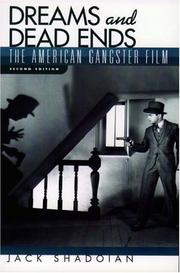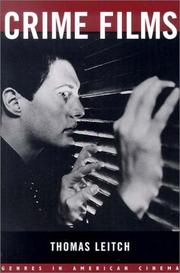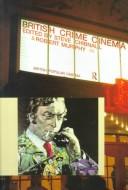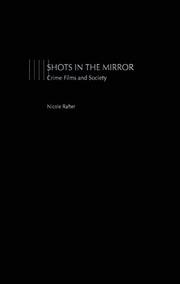| Listing 1 - 10 of 14 | << page >> |
Sort by
|
Book
ISBN: 1442230762 9781442230767 9781442230750 1442230754 Year: 2014 Publisher: Lanham, Maryland : Rowman & Littlefield,
Abstract | Keywords | Export | Availability | Bookmark
 Loading...
Loading...Choose an application
- Reference Manager
- EndNote
- RefWorks (Direct export to RefWorks)
In this book, noted film and literature scholar Gene D. Phillips looks at the crime film genre. In addition to the usual suspects like Little Caesar, and The Godfather Part II, which he examines with a fresh perspective, Phillips also calls attention to some of the less heralded but no less worthy films and filmmakers that represent the genre.
Book

ISBN: 2869064780 2869061609 Year: 2017 Publisher: Tours : Presses universitaires François-Rabelais,
Abstract | Keywords | Export | Availability | Bookmark
 Loading...
Loading...Choose an application
- Reference Manager
- EndNote
- RefWorks (Direct export to RefWorks)
Le présent volume réunit les textes correspondant aux communications de la journée de la SENA organisée à l'université de Tours le 19 janvier 2002, à propos de la question de civilisation américaine de l'agrégation d'anglais : le crime organisé à la scène et à l'écran, 1929- 1951. L'approche choisie a été de confronter les connaissances historiques relatives à ce sujet à sa représentation offerte par certains des films d'Hollywood.
Sociology --- Film Radio Television --- gangster --- criminalité --- fiction --- film noir --- cinéma --- États-Unis
Book
ISBN: 1683352351 9781683352358 9781419729157 1419729152 Year: 2018 Publisher: New York : Abrams Image,
Abstract | Keywords | Export | Availability | Bookmark
 Loading...
Loading...Choose an application
- Reference Manager
- EndNote
- RefWorks (Direct export to RefWorks)
Rap (Music) --- Gangsta rap (Music) --- Gangster rap (Music) --- History and criticism.
Book
ISBN: 0252052498 9780252052491 9780252043611 9780252085543 0252043618 025208554X Year: 2021 Publisher: Urbana, Illinois : University of Illinois Press,
Abstract | Keywords | Export | Availability | Bookmark
 Loading...
Loading...Choose an application
- Reference Manager
- EndNote
- RefWorks (Direct export to RefWorks)
In the 1950s, the gangster movie and film noir crisscrossed to create gangster noir. Robert Miklitsch takes readers into this fascinating subgenre of films focused on crime syndicates, crooked cops, and capers. With the Senate's organised crime hearings and the brighter-than-bright myth of the American Dream as a backdrop, Miklitsch examines the style and history, and the production and cultural politics, of classic pictures from The Big Heat and The Asphalt Jungle to lesser-known gems like 711 Ocean Drive and post-Fifties movies like Ocean's Eleven. Miklitsch pays particular attention to trademark leitmotifs including the individual versus the collective, the family as a locus of dissension and rapport, the real-world roots of the heist picture, and the syndicate as an octopus with its tentacles deep into law enforcement, corporate America, and government.
Gangster films --- Film noir --- Motion pictures --- History and criticism. --- Social aspects --- History
Book
ISBN: 1501748351 1501748343 1501749595 Year: 2021 Publisher: Ithaca : Northern Illinois University Press,
Abstract | Keywords | Export | Availability | Bookmark
 Loading...
Loading...Choose an application
- Reference Manager
- EndNote
- RefWorks (Direct export to RefWorks)
'City of Big Shoulders' links key events in Chicago's development, from its marshy origins in the 1600s to today's robust metropolis. Robert G. Spinney presents Chicago in terms of the people whose lives made the city-from the tycoons and the politicians to the hundreds of thousands of immigrants from all over the world. In this revised and updated second edition that brings Chicago's story into the 21st century, Spinney sweeps his historian's gaze across the colourful and dramatic panorama of the city's explosive past. How did the pungent swamplands that the Native Americans called 'the wild-garlic place' burgeon into one of the world's largest and most sophisticated cities? What is the real story behind the Great Chicago Fire? What aspects of American industry exploded with the bomb in Haymarket Square? Could the gritty blue-collar hometown of Al Capone become a visionary global city?

ISBN: 0195142918 0195142926 0195302753 1280531274 0198032633 1602567999 9780198032632 9780195142921 9780195142914 9780195302752 9786610531271 6610531277 9781280531279 9781602567993 0199881707 0197723861 Year: 2003 Publisher: Oxford ; New York : Oxford University Press,
Abstract | Keywords | Export | Availability | Bookmark
 Loading...
Loading...Choose an application
- Reference Manager
- EndNote
- RefWorks (Direct export to RefWorks)
This work provides a history of the 20th-century American gangster film. Moving chronologically through nearly seven decades, this volume offers illuminating readings of a select group of the classic films that best define and exemplify each period in the development of the American crime film.
Film --- United States --- Gangster films --- History and criticism. --- Music, Dance, Drama & Film --- History and criticism --- Bandit gangster films --- Gang films --- Gangland films --- Hoodlum drama (Motion pictures) --- Mafia films --- Organized crime films --- Outlaw-couple films --- Outlaw gangster films --- Rural bandit films --- Syndicate films --- Syndicate-oriented films --- Crime films --- United States of America

ISBN: 1107128064 0511040288 0511148534 0511556187 0511606451 0511051514 9780511040283 9780511606458 9780511051517 0511036280 9780511036286 9780511148538 9786612389283 6612389281 9780511643118 051164311X 0521641063 0521646715 9780521641067 9780521646710 9780511556180 9781107128064 Year: 2002 Publisher: Cambridge ; New York : Cambridge University Press,
Abstract | Keywords | Export | Availability | Bookmark
 Loading...
Loading...Choose an application
- Reference Manager
- EndNote
- RefWorks (Direct export to RefWorks)
This book surveys the entire range of crime films, including important subgenres such as the gangster film, the private eye film, film noir, as well as the victim film, the erotic thriller, and the crime comedy. Focusing on ten films that span the range of the twentieth century, Thomas Leitch traces the transformation of the three leading figures that are common to all crime films: the criminal, the victim and the avenger. Analyzing how each of the subgenres establishes oppositions among its ritual antagonists, he shows how the distinctions among them become blurred throughout the course of the century. This blurring, Leitch maintains, reflects and fosters a deep social ambivalence towards crime and criminals, while the criminal, victim and avenger characters effectively map the shifting relations between subgenres, such as the erotic thriller and the police film, within the larger genre of crime film that informs them all.
Detective and mystery films --- Gangster films --- Police films --- Cop films --- Crime films --- Bandit gangster films --- Gang films --- Gangland films --- Hoodlum drama (Motion pictures) --- Mafia films --- Organized crime films --- Outlaw-couple films --- Outlaw gangster films --- Rural bandit films --- Syndicate films --- Syndicate-oriented films --- History and criticism. --- Criminal films --- Motion pictures --- Caper films --- Thrillers (Motion pictures)

ISBN: 0415168708 0415168694 9780415168694 9780415168700 9780203979914 0203979915 1134702701 1280139021 9786610139026 6610139024 9781134702701 9781280139024 9781134702657 9781134702695 1134702698 Year: 1999 Volume: *2 Publisher: London ; New York : Routledge,
Abstract | Keywords | Export | Availability | Bookmark
 Loading...
Loading...Choose an application
- Reference Manager
- EndNote
- RefWorks (Direct export to RefWorks)
This is the first substantial study of British cinema's most neglected genre. Bringing together original work from some of the leading writers on British popular film, this book includes interviews with key directors Mike Hodges (Get Carter) and Donald Cammel (Performance). It discusses an abundance of films including:* acclaimed recent crime films such as Shallow Grave, Shopping, and Face.* early classics like They Made Me A Fugitive* acknowledged classics such as Brighton Rock and The Long Good Friday* 50
Gangster films --- Great Britain --- History and criticism --- 799.1 --- 798.43 --- misdaadfilm --- filmgeschiedenis --- Groot-Brittannië --- Bandit gangster films --- Gang films --- Gangland films --- Hoodlum drama (Motion pictures) --- Mafia films --- Organized crime films --- Outlaw-couple films --- Outlaw gangster films --- Rural bandit films --- Syndicate films --- Syndicate-oriented films --- Crime films --- filmgenres en -motieven, misdaad- en avonturenfilms --- film, geschiedenis der filmkunst, overige landen --- Motion pictures --- Cinema --- Feature films --- Films --- Movies --- Moving-pictures --- Audio-visual materials --- Mass media --- Performing arts --- History and criticism.

ISBN: 1280472332 019802973X 1602563683 9780198029731 1423760379 9781423760375 9781280472336 0195129822 9780195129823 9786610472338 6610472335 9781602563681 0197726135 Year: 2000 Publisher: Oxford ; New York : Oxford University Press,
Abstract | Keywords | Export | Availability | Bookmark
 Loading...
Loading...Choose an application
- Reference Manager
- EndNote
- RefWorks (Direct export to RefWorks)
Criminologist Nicole Rafter analyses the source of the appeal of crime films, and their role in popular culture. She argues that crime films both reflect and shape our ideas about fundamental social, economic and political issues.
Crime films --- Justice, Administration of, in motion pictures. --- Motion pictures --- Criminal films --- Caper films --- Thrillers (Motion pictures) --- History and criticism. --- Social aspects --- Gangster films --- Police films --- Prison films
Book
ISBN: 9781477323991 Year: 2022 Publisher: Austin : University of Texas Press,
Abstract | Keywords | Export | Availability | Bookmark
 Loading...
Loading...Choose an application
- Reference Manager
- EndNote
- RefWorks (Direct export to RefWorks)
"In the mid 1970s, one of Austin's biggest criminals was getting rich on bail bonds and auto salvage (he owned a junkyard). With the help of corrupt local officials, including the sheriff, Frank Smith had a small empire, but he had one rival in the salvage business and one day he sent some tough guys to take care of the problem. The "Fellini-esque" shootout eventually led to Smith's arrest and indictment, setting up a courtroom battle with the new DA, Ronnie Earle. Earle would go on to serve 32 years as Travis County's top prosecutor, indicting figures as notorious as congressman Tom DeLay, but always maintained that the Smith case was the biggest of his career. This book tells the story of Frank Smith, his rise to local infamy, the subsequent trial, and its fallout. Along the way, Sublett paints a picture of the seedier side of 1970s Austin, with appearances from Willie Nelson, private eyes, brothel owners, and hired guns"--
| Listing 1 - 10 of 14 | << page >> |
Sort by
|

 Search
Search Feedback
Feedback About UniCat
About UniCat  Help
Help News
News